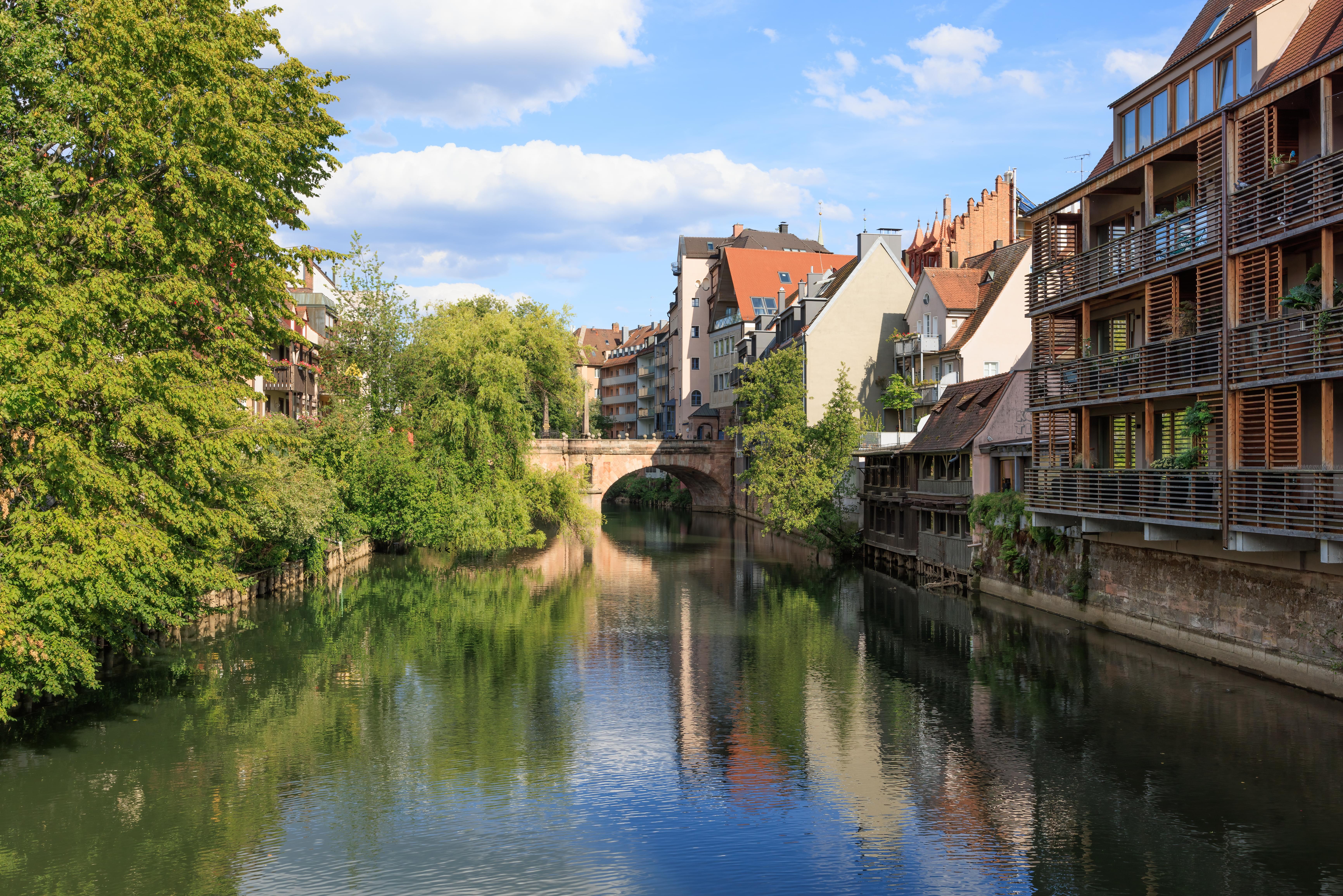After taking the ICE from Frankfurt Airport, we arrived in Nürnberg, or Nuremberg in English, before noon. After checking into our hotel, the Le Meridien Grand Hotel, right next to the train station, we headed over to see the courtroom where the Nürnberg trials took place after World War II. We spent the rest of the afternoon walking through part of the Altstadt, or old town, in the middle of the city.
Le Meridien Grand Hotel
Immediately upon arriving in Nürnberg, we crossed the street to check-in at the Le Meridien Grand Hotel. We booked a Deluxe room as the lowest tier Petit rooms are quite small. We were upgraded to a Junior Suite, which can be best described as a larger room.
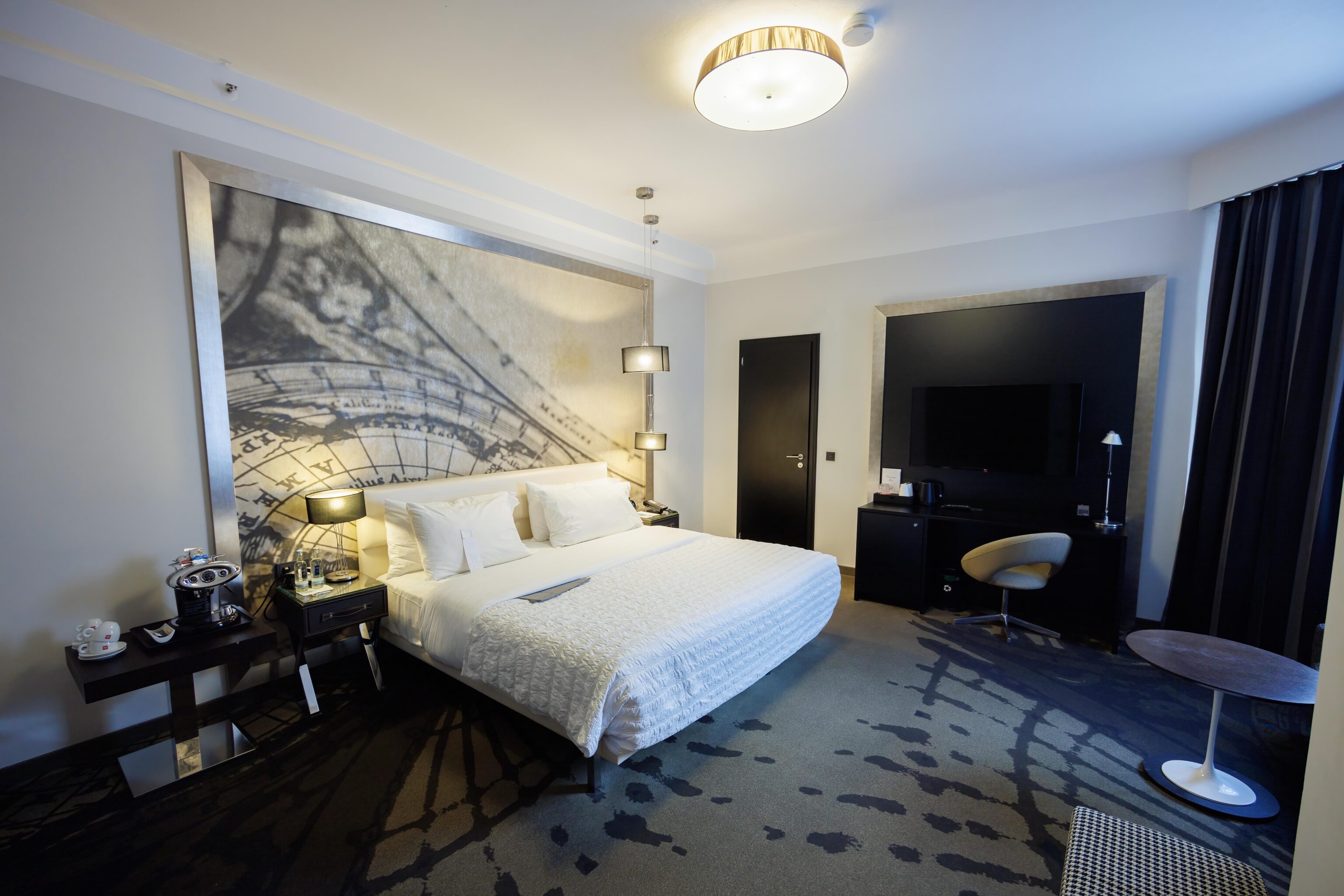

There isn’t really anything that really differentiates this room as a junior suite vs. a non-suite room. That said, we were perfectly happy with it. It was quite spacious and offered everything we needed for our stay.
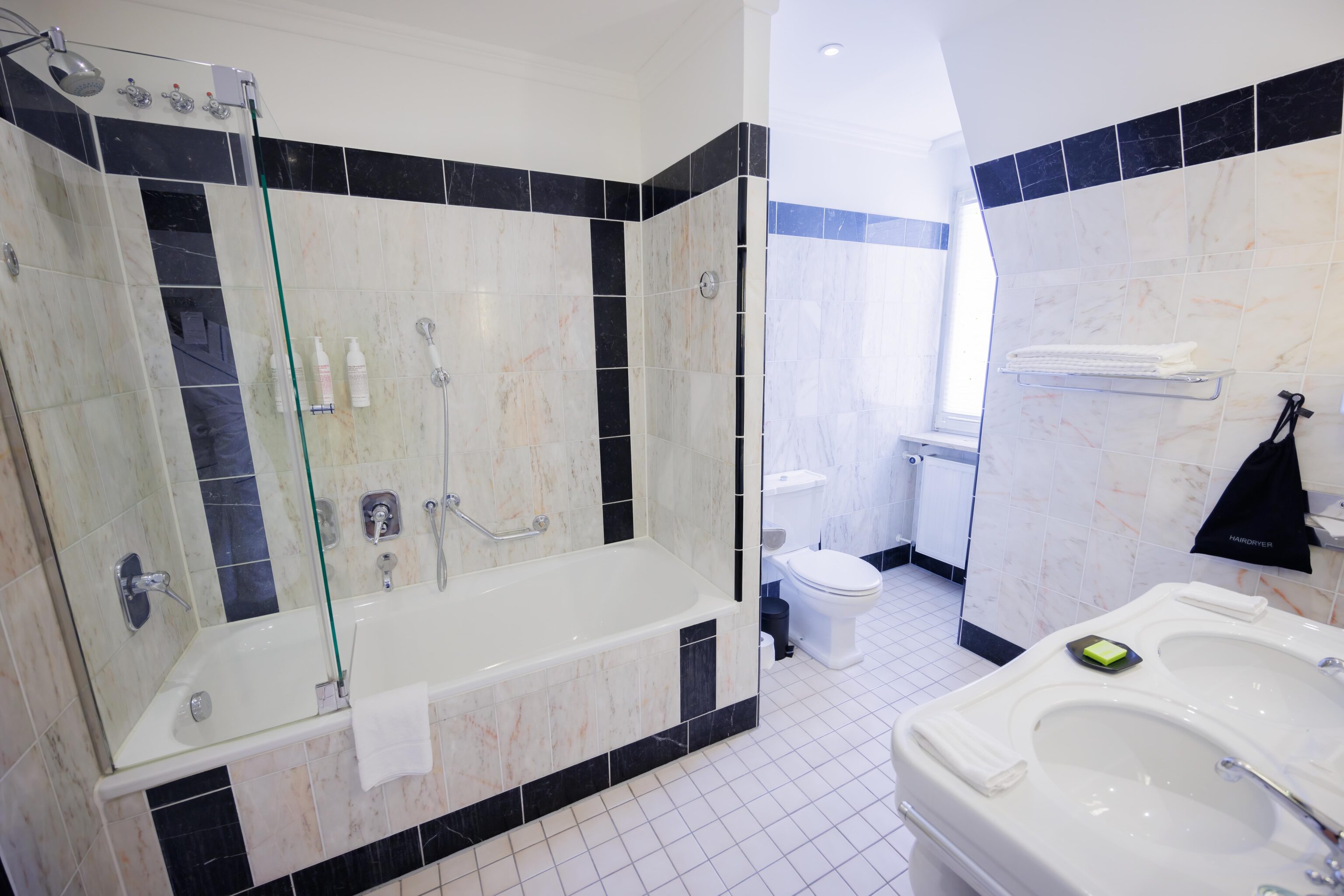
The bathroom was large with twin sinks and a bathtub.

Our room didn’t have a view, though the interior facing location did make it very quiet during all hours.
Memorium Nürnberger Prozesse
After leaving the hotel, we took the U-Bahn to visit the Memorium Nürnberger Prozesse, the memorial museum for the Nürnberg trials.

The main remaining artifact from the trials is Courtroom 600, the actual room where the trials took place. The room is still in use for the courts today so is not always available to see. Luckily for us, today it was open. The museum website has an excellent virtual tour of the room.

The courtroom is not in the same layout as it was during the trials. It had been modified specifically for the trials and has been modified afterwards as well. However, this marble element above the door was present at the time. The virtual tour has a good description:
Like the other two, this largest and most elaborate of the portals comprises a marble door surround (here a double door) and a bronze cartouche in the architrave. But the cartouche above this portal stands out by completing the architrave itself, not merely being set in front of a field within the marble portal. It is also flanked by two figures, also of bronze: one symbolizing Roman law, and the other Germanic law. The cartouche contains a representation of symbols with meaning for the legal field - here, Adam and Eve eating from the Tree of Knowledge and thus committing the Original Sin. Design: Ernst Pfeiffer, casting: Christoph Lenz.

There is an exhibition on the second floor above the courtroom level. It consists mostly of signs with a few photographs and tons of text in German. There is an audio guide, included with the entry ticket, that roughly reads out the text. It would take many hours to hear everything.

There are very few actual artifacts in the museum. This is a box that was used to transport evidence gathered by the US Army.

These are original benches used by the defendants. They were purposely crafted to be extremely plain to show that to the law, the defendants were essentially just regular people without any special rights.

This display was interesting, not because the details were particularly important but because of the building in the middle photo. It is the Grand Hotel. The same hotel that we are staying at! It was family owned at the time and has since been sold to a corporate entity but still maintains the same general appearance from the exterior.
The text related to the photo reads, mostly translated to English by Google Translate:
The Grand Hotel at the Station Square, 1945. It was not just a place for official guests, but an international meeting place for process workers.
The bottom photo is also from the hotel. The text, again translated to English by Google Translate:
Evening fun for the trial participants with dance performance at the Grand Hotel.
There are numerous references to the Grand Hotel and the trials on the Internet. The Philadelpha Sunday Sun wrote:
The Grand Hotel is situated directly across from the main train station and is accessible to all the city sites either by public transit or walking. The hotel was family owned and they refused Hitler a room in the 1920s because they disagreed with his politics. He never tried to stay there again. While the Nuremberg Trials were taking place several of the judges lodged there. Built in 1897, it is considered one of the world’s greatest hotels.
Famous Trials By Professor Douglas O. Linder wrote:
The city was 91% destroyed, but in addition to the Palace of Justice, the best hotel in town--the Grand Hotel--was miraculously spared and served as an operating base for court officers and the world press.
and
Members of the world press moved into the Grand Hotel and whatever other quarters they could find and began writing background features on the upcoming trial.

For whatever reason, the panel used to control the courtroom lighting was preserved. An adjacent sign states that bright lights had to be installed in order to film the trials, and as a result some defendants wrote sunglasses.
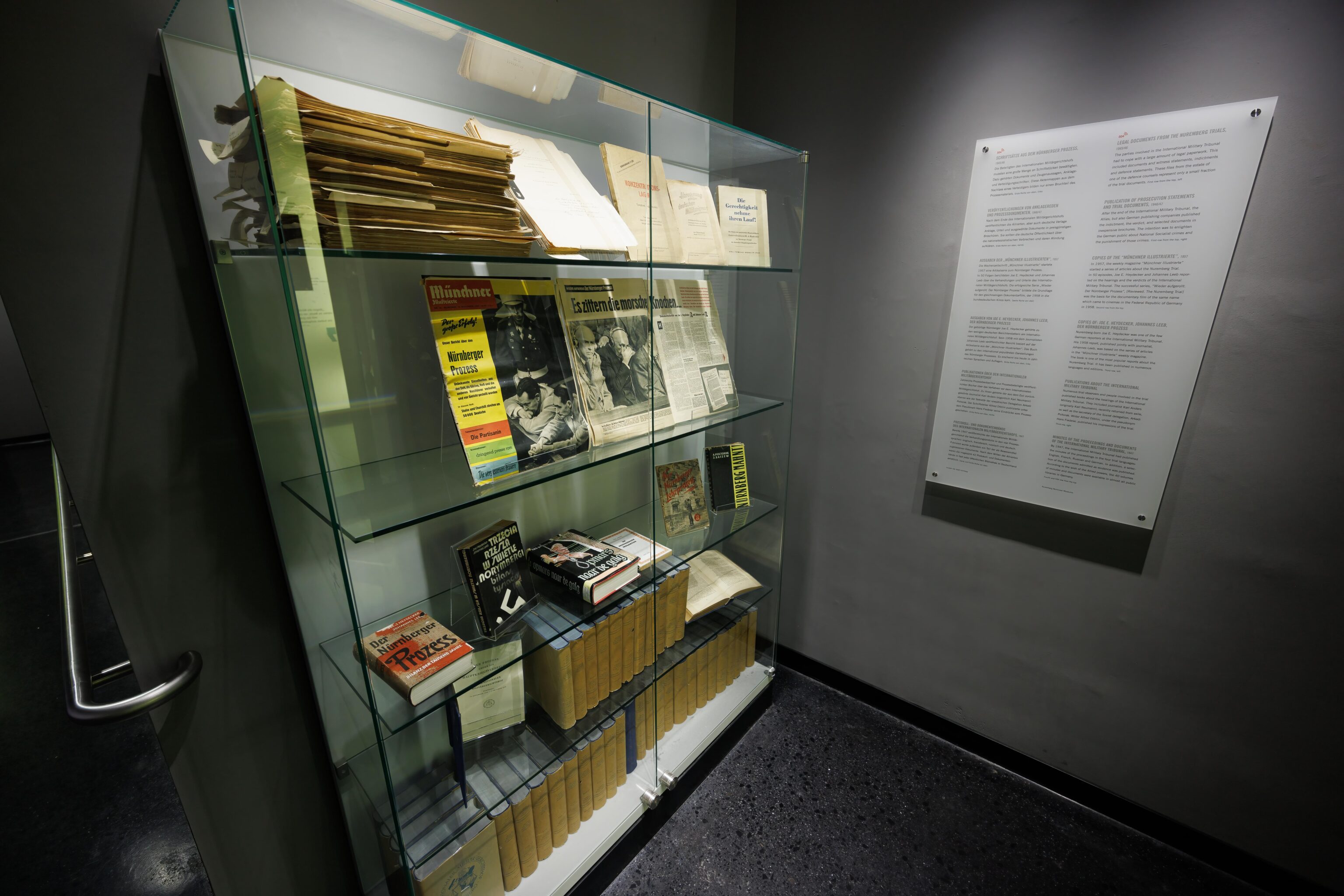
A collection of documents, books, and other written items related to the trials.
We ultimately spent a bit more than an hour in the museum. It really needs something like a 30 minute audio guide that walks through the most important points related to the trials as well as the section of Nürnberg as the location.

Courtroom 600 is on the right side of the building with the four big windows on the 2nd floor, or as we’d call it in the US, the 3rd floor.
Altstadt
Afterwards, we took the U-Bahn to Plärrer where we intended on taking the tram to the north end of the old town. However, we eventually figured out there was some issue and all all the trams on the route we wanted to take were terminating at Plärrer. We ended up returning to the U-Bahn and continuing on to Lorenzkirche. When we exited the station, we noticed some market stands on the bridge across the Pegnitz River. We ended up getting some strawberries and continued walking to the north. We noticed that there was quite a bit of construction activity at the Nürnberg Hauptmarkt. It looked like they were constructing a stage, perhaps for a music festival or something similar?
We ultimately decided to get a late lunch at Die Wirtschaft just beyond the far side of the Nürnberg Hauptmarkt. Die Wirtschaft specializes in Fränkisch cuisine. Fränkisch refers to Franconia, a region of Germany that includes Nürnberg.

Roasted pork shoulder with darkbeer gravy,
potato dumpling and a small mixed salad

as „Saure Zipfel“, boiled in a wine-onion stock served with bread
The pork shoulder turned out to be cooked just as pork knuckle is cooked. It was good and had a bit of crispy skin attached. The potato dumplings were interesting as the texture was a little bit like mochi.
The bratwurst was interesting as well because we’ve never had it this way in a soup. The soup flavor was definitely very different from what we’ve had before. Good but a bit weird.
Overall, a very good late lunch!
Sebalduskirche
After leaving the restaurant, we walked one block to the north to visit Sebalduskirche (St. Sebald Church).
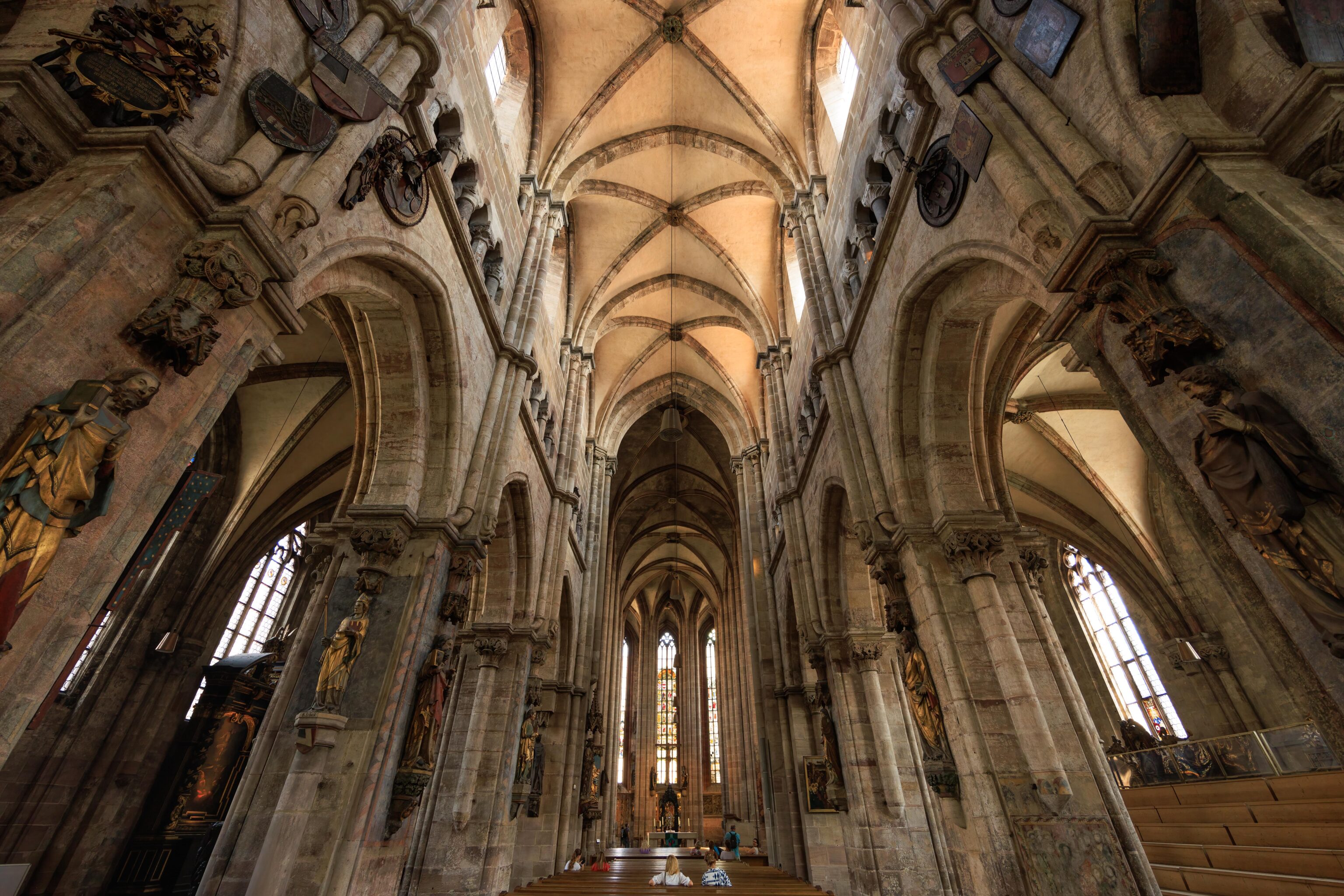
The church is large and occupies an entire block, though these old city blocks aren’t very big. Inside, well, it looks like a European church.

This is the Catherine Altar. The church website describes, translated to English by Google Translate:
Scenes from the legends of the saints about the life and death of Saint Catherine are depicted on the Catherine altar, which the patrician Wilhelm Loeffelholz donated for the west choir. Created between 1462 and 1464, it has only been reconstructed in its old location since 2004. Previously, the individual parts were divided on the sides of the west choir. The carved altarpiece depicts the miracle of the wheel and the beheading of Saint Catherine after the. The "Master of the Catherine Altar" painted the wings, which when open show scenes from Catherine's life. When closed, they depict the Adoration of the Magi and Saint George fighting the dragon.

There were various paintings on the walls that had faded quite a bit. They must have been quite colorful when new!
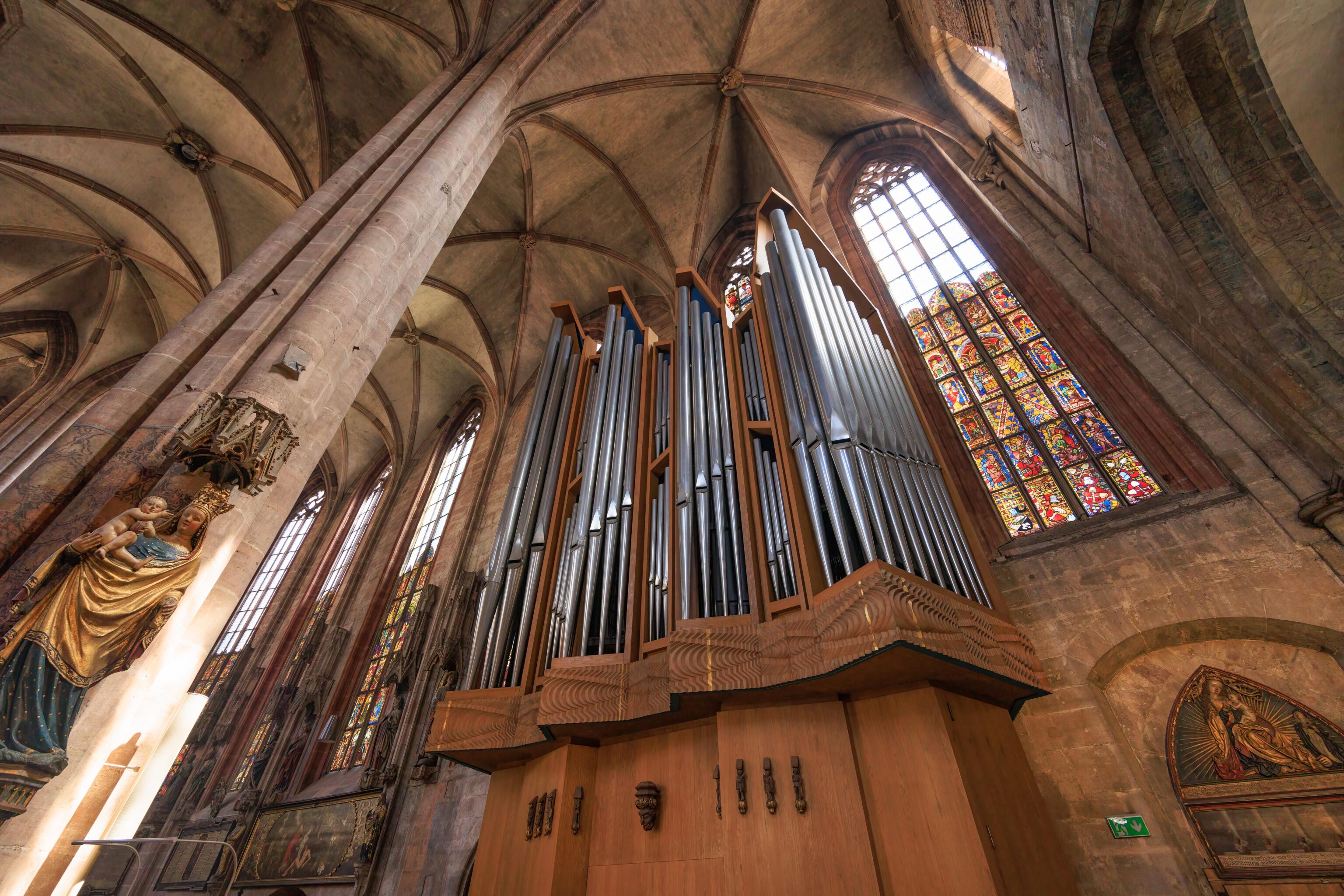
There is, of course, an organ. The church website describes, translated to English by Google Translate:
With the "Traxdorff" organ from 1440 that burned down in 1945, today's "Peter" organ from 1975 has a traditional predecessor. Famous organists such as the blind Conrad Paumann (between 1446 and 1450) and Johann Pachelbel, Johann Sebastian Bach's teacher (between 1695 and 1706) played on Heinrich Traxdorff's organ. Restored and renewed several times up until the 1930s, they were the oldest playable organ in the world until they were destroyed on January 2, 1945. After the Second World War, the Sebaldus Church received a discarded organ from the Oettinger Jakobskirche from 1904 in 1947. In 1975, the provisional arrangement was completed with the construction of a new organ by the Cologne organ building company Peter.
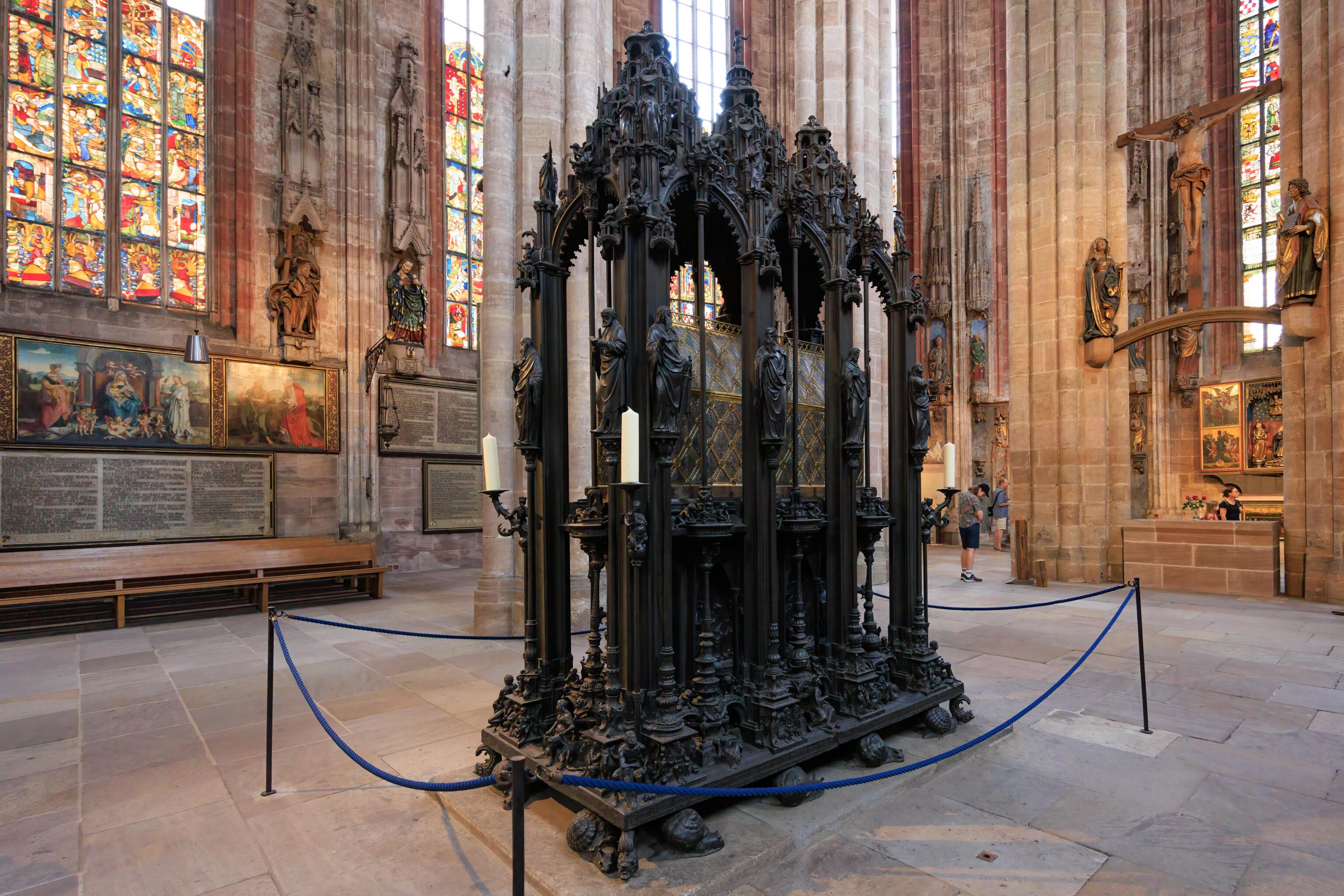
At the time, we didn’t know the significance of this item. It was obviously important and in a very prominent location. The church website describes, again translated to English by Google Translate:
In eleven years, Peter Vischer d.Ä. and his sons Peter and Hermann with the Sebaldus grave the most beautiful cast work of art north of the Alps. A cast brass tomb for the city saint Sebald has been planned since at least 1488. In 1507 the final decision was made to "make the case for the Holy Prince of Heaven Sebolten's sarch made of brass". The Nuremberg patricians involved and the Sebalder church master Sebald Schreyer contributed 2335 to the total cost of 3145 guilders from their private assets. The remainder was to be raised from the city treasury. Overall, the grave cost around four and a half times as much as the Dürer house, which cost around 700 guilders. It became a masterpiece of Nuremberg casting art of the Renaissance, which is extremely bold in its pictorial program.
The translation isn’t so great, but the important thing is, this is the tomb of St. Stebald, the namesake of the church.

This is described as the crucifixion group. The church website explains, translated to English by Google Translate:
It was not until 1663 that the figures of the Crucified, the Sorrowful Mother Mary and the favorite disciple Johannes came from Veit Stoss from the Frauenkirche to the Sebalduskirche. Since then they have formed the crucifixion group above the former main altar. While the painted figures of Mary and John were created in the years 1507/1508, the depiction of the crucified Jesus is much younger. Only at the beginning of the 20th century did it become clear that the crucifix also came from Veit Stoss. When the Sebaldus Church was restored at the time, a document was found inside with reference to the founder Niklas Wickel, the year of the foundation 1520 and the artist Veit Stoss. Stoss designed all three lime wood figures extremely dramatically. The side wound shows that the Crucified is already dead, his features still reflecting the agony. Maria's hands show the same tension between pain and release. Although John weeps, he confidently holds his gospel in front of him.

While in the church, we noticed various sculptures and other works of art around the edge of the building. They seemed to be for sale as a fundraiser. This one is going for 8,500€! The bold text says, do not touch, and indeed, we did not.
Sebalduskirche to Lorenzkirche
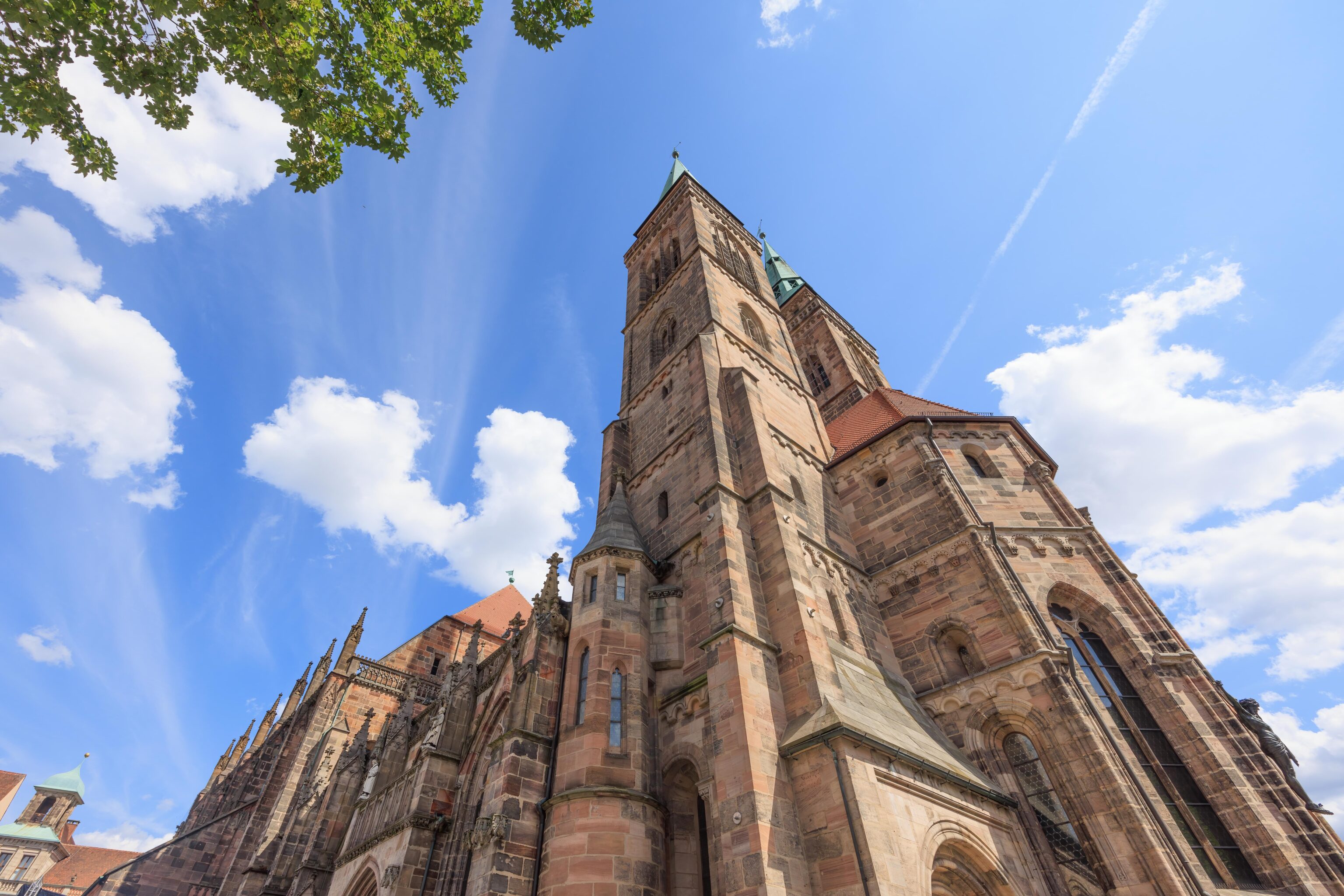
We walked around the outside of the church for a bit but it is hard to photograph such a large structure from close by.
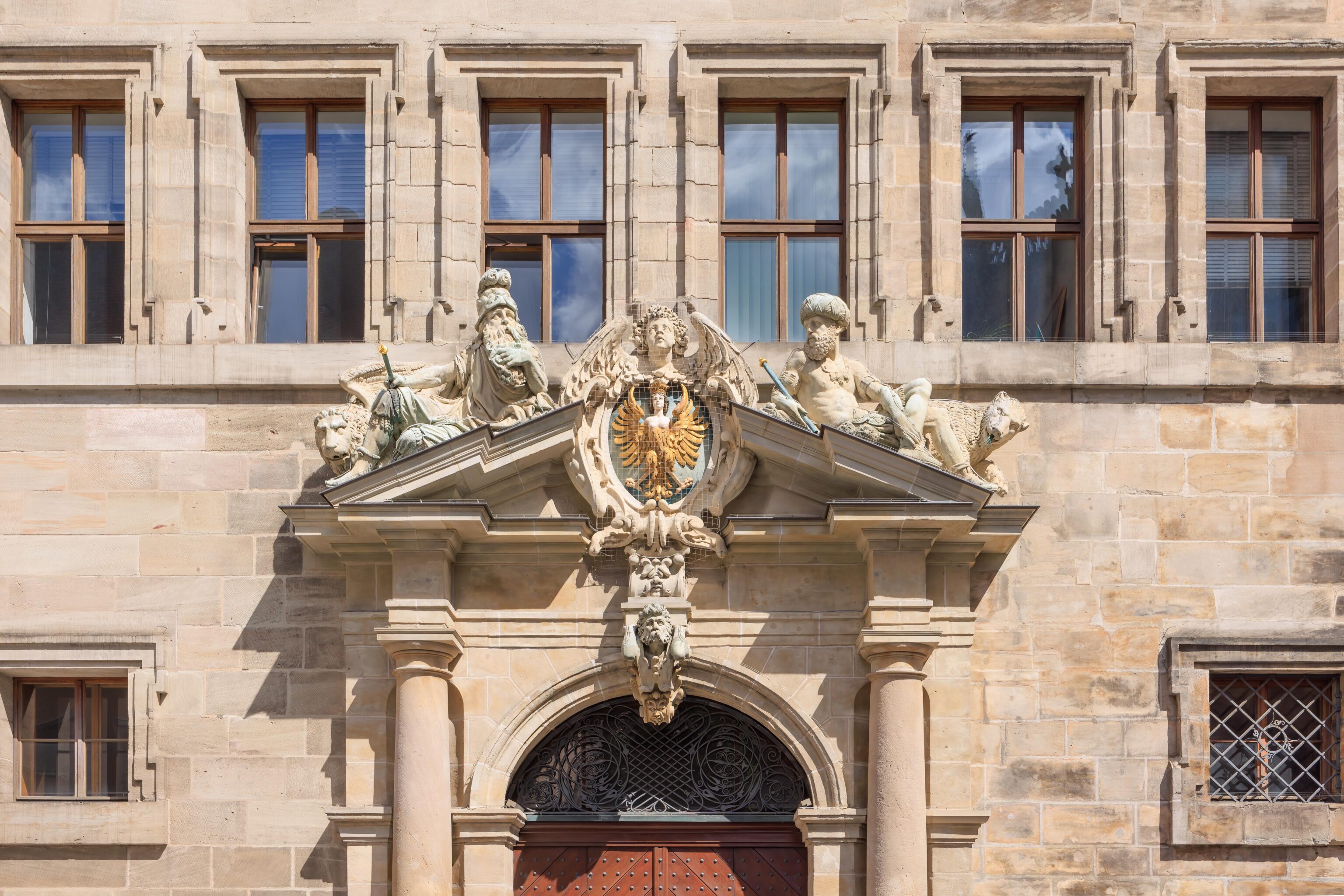
We noticed this particular building just to the east of the church. It seemed to be finely decorated.

It turns out this building is the Altes Rathaus (Old City Hall).

We could see the church’s two towers from the Hauptmarkt, a block away to the south.


This very fancy structure is the well named Schöner Brunnen (Beautiful Fountain). Some sources mention that this is a replica with the original in the Germanisches Nationalmuseum (German National Museum). It does seem that parts of the fountain may be in the museum while other parts have been reconstructed rather than the entire fountain being a replica.
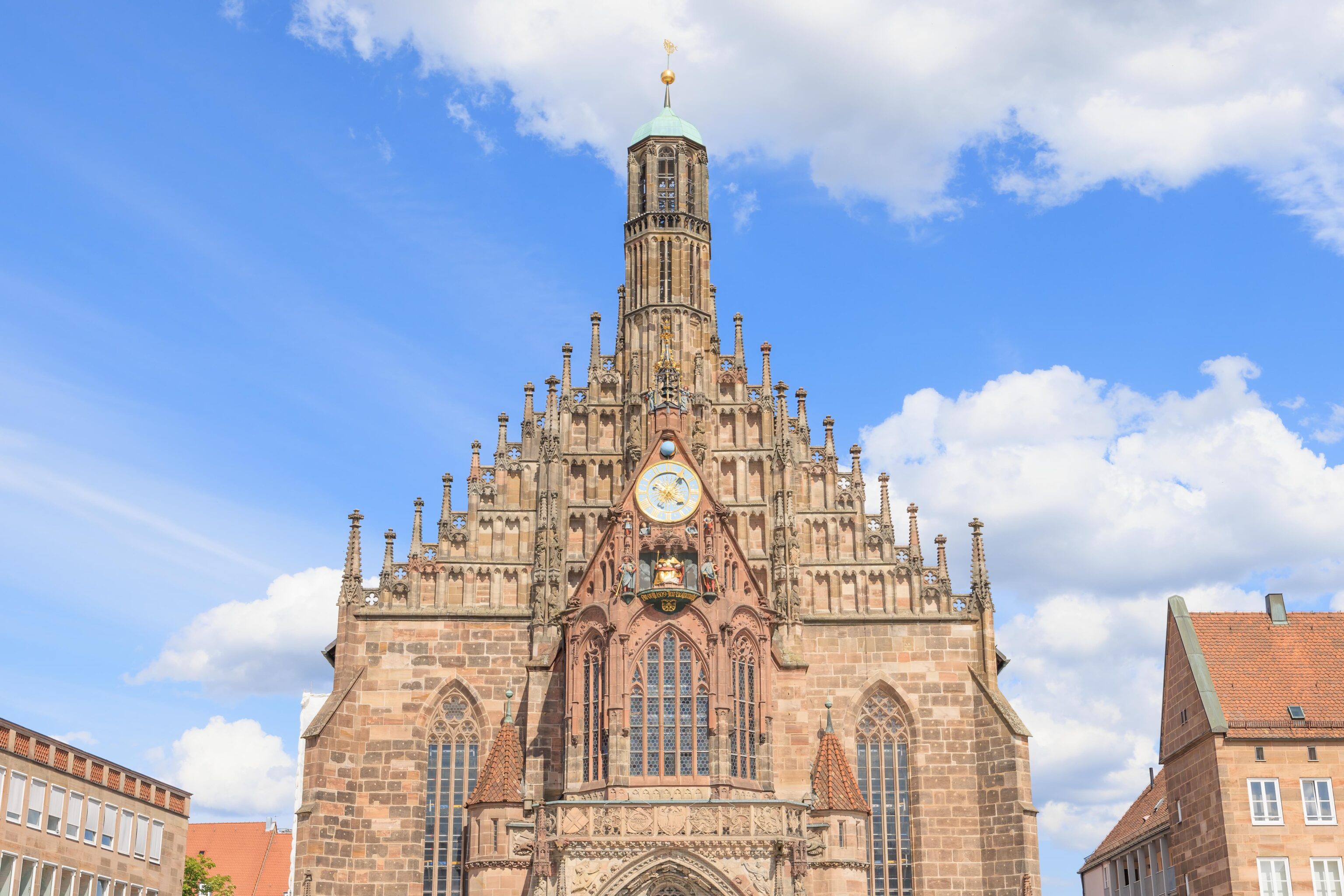
The Frauenkirche (Church of our Lady) is on the eastern edge of the Hauptmarkt. It is currently closed for renovations. Unfortunately, there was a large tractor trailer parked directly in front of the building so we couldn’t see what the lower portion looked like. The church’s website is mostly in German but they do have an English PDF that provides some background information.
We popped into Buonissimo, an Italian ice cream shop at the southeastern corner of the Hauptmarkt.

We ended up getting an apple sorbet and their special pistachio ice cream. The pistachio was very good. The apple was interesting as one does not often run into apple as a flavor. It was a bit weak but still nice for the warm summer afternoon.

We continued walking to the south, past the Hauptmarkt and once again across the Pegnitz River via the Museumsbrücke (Museum Bridge). The bridge has some pretty river views! This was the scene to the east.
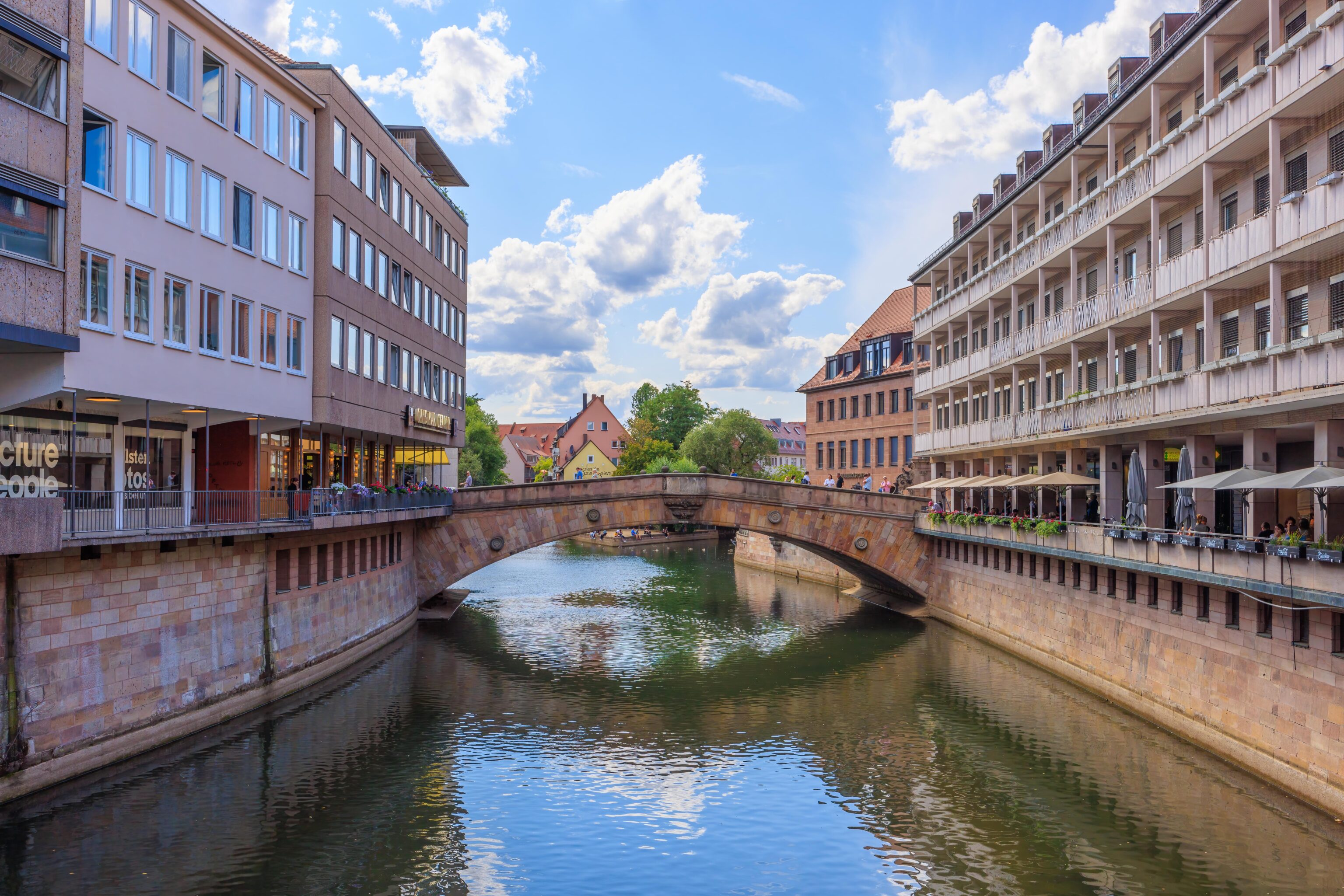
And this was the scene to the west.
Lorenzkirche
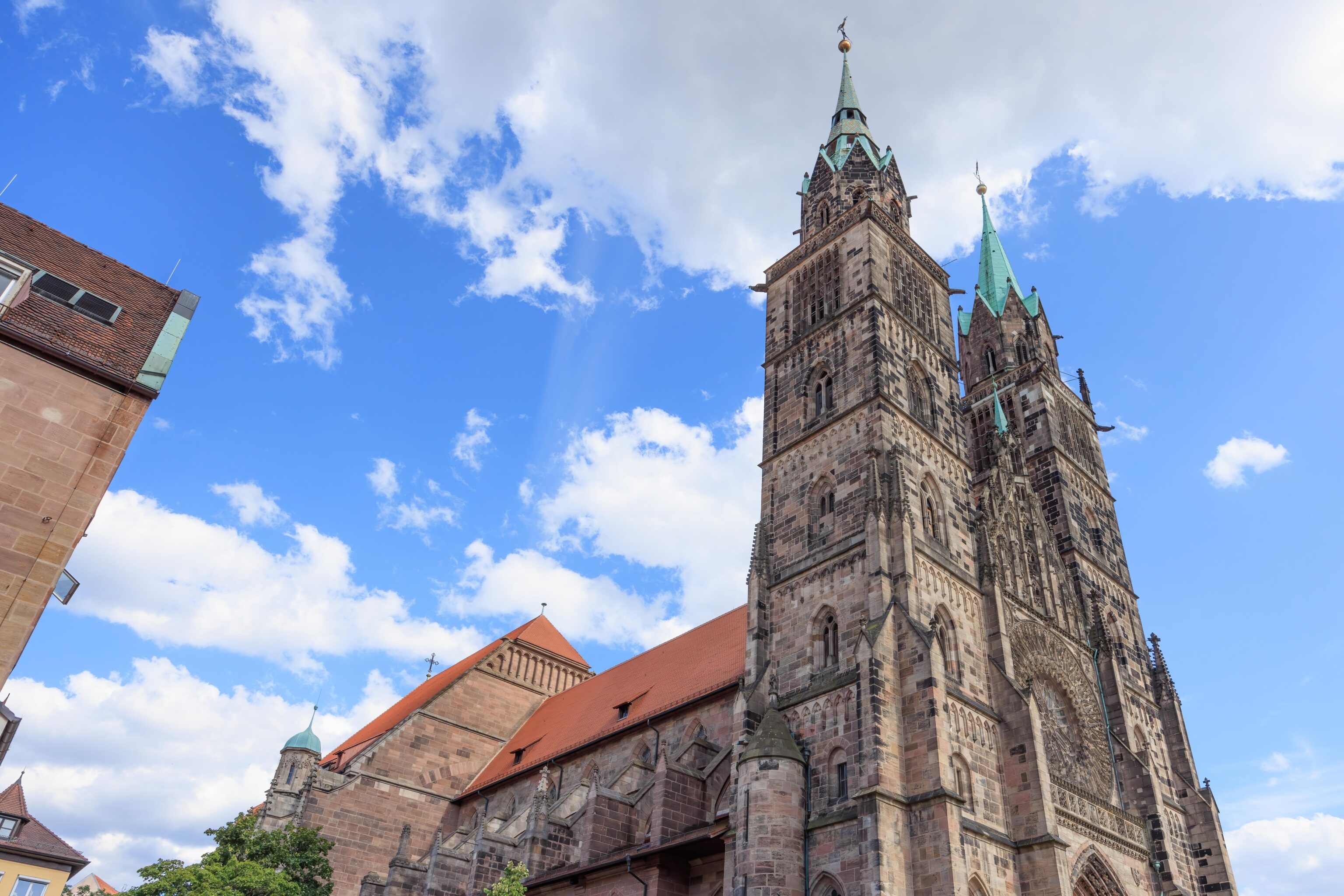
After walking past the U-Bahn station where we arrived earlier, we reached the Lorenzkirche (St. Lawrence Church). Once again, a big church!
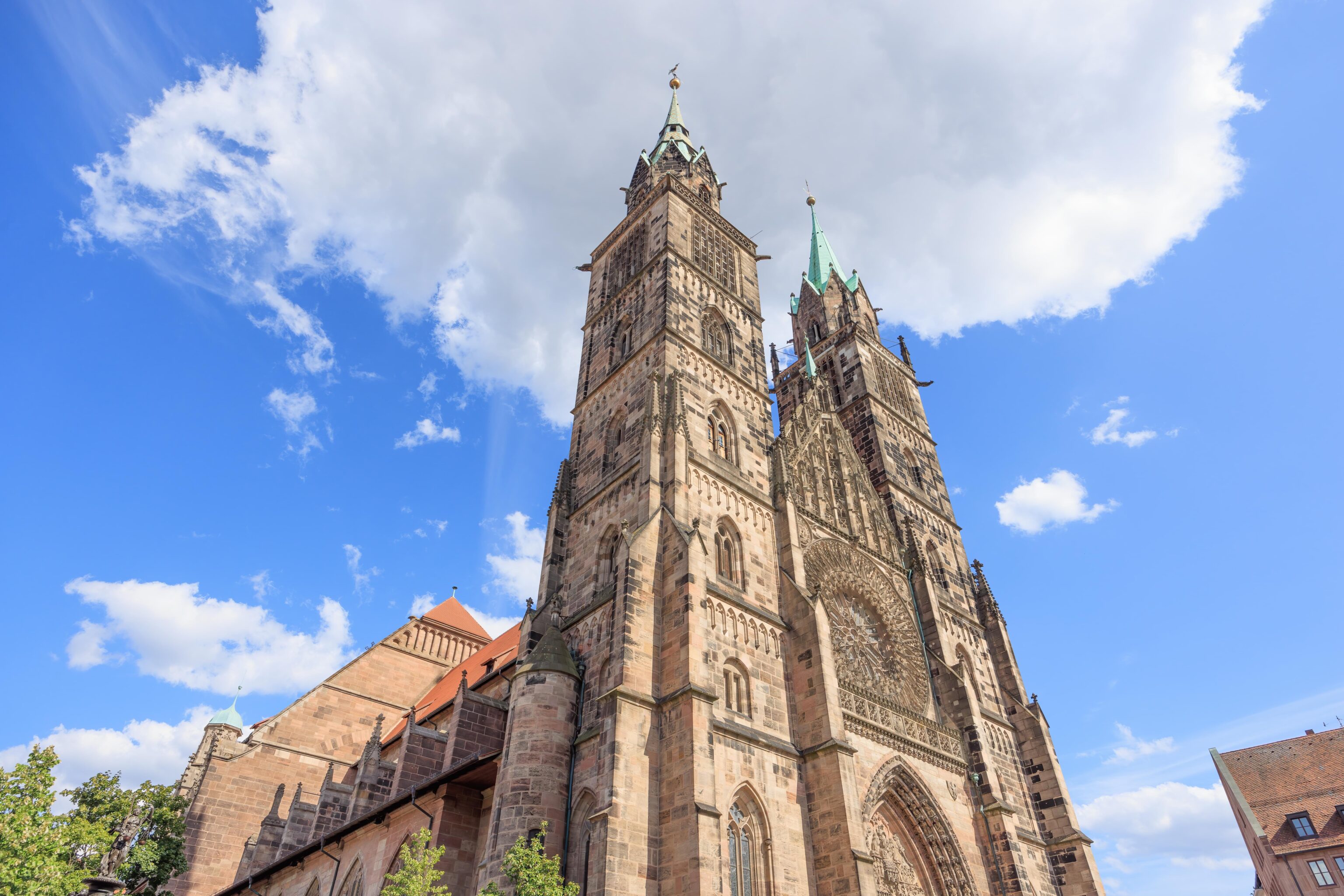
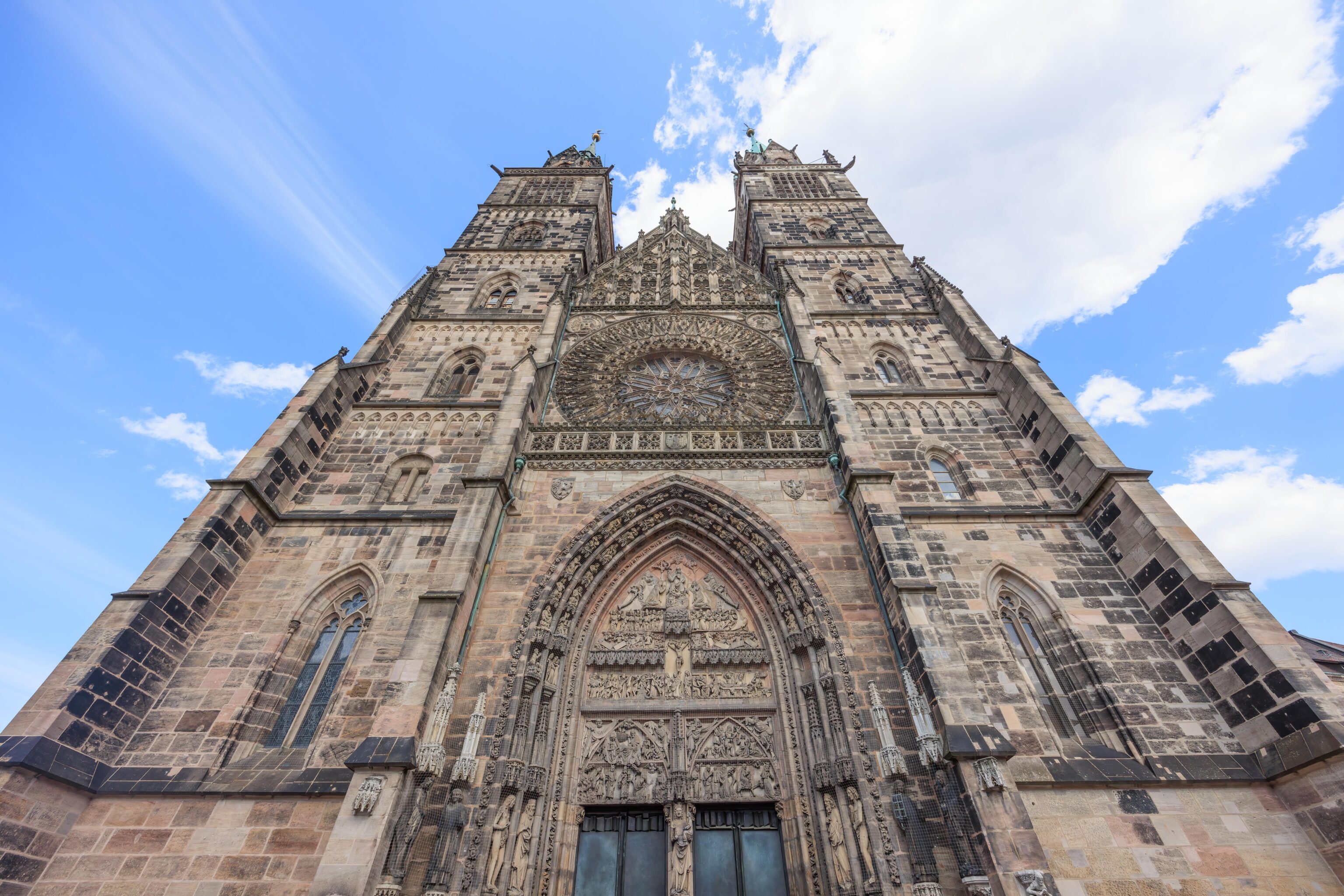
We continued walking to find the entrance…

The entrance was on the south side! Once we were inside, well, it looked like a European church!

Like many historic structures in Germany, it was damaged during World War II.
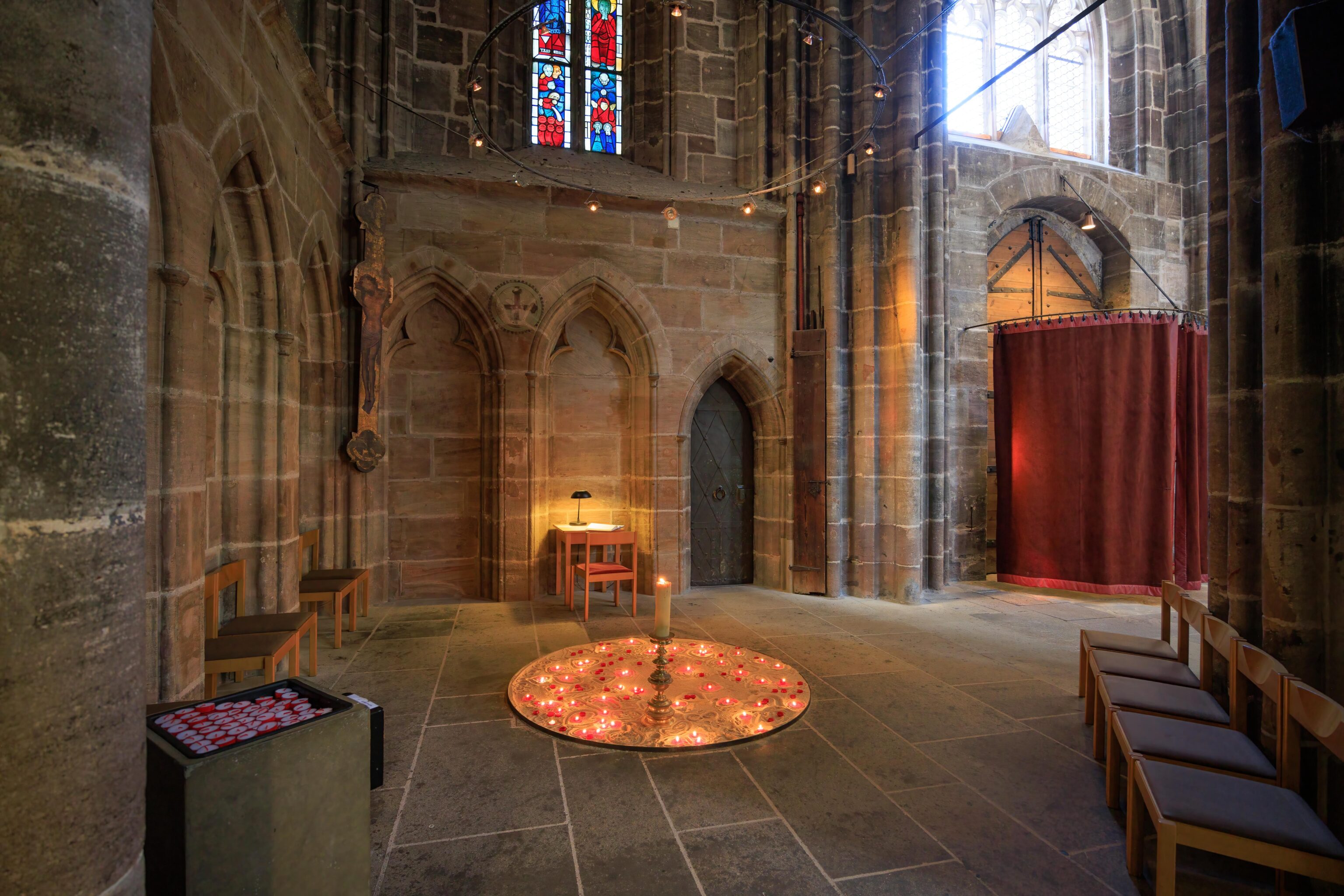
Sometimes, the candles go on a metal structure. Here, they go on a circular pit of sand.


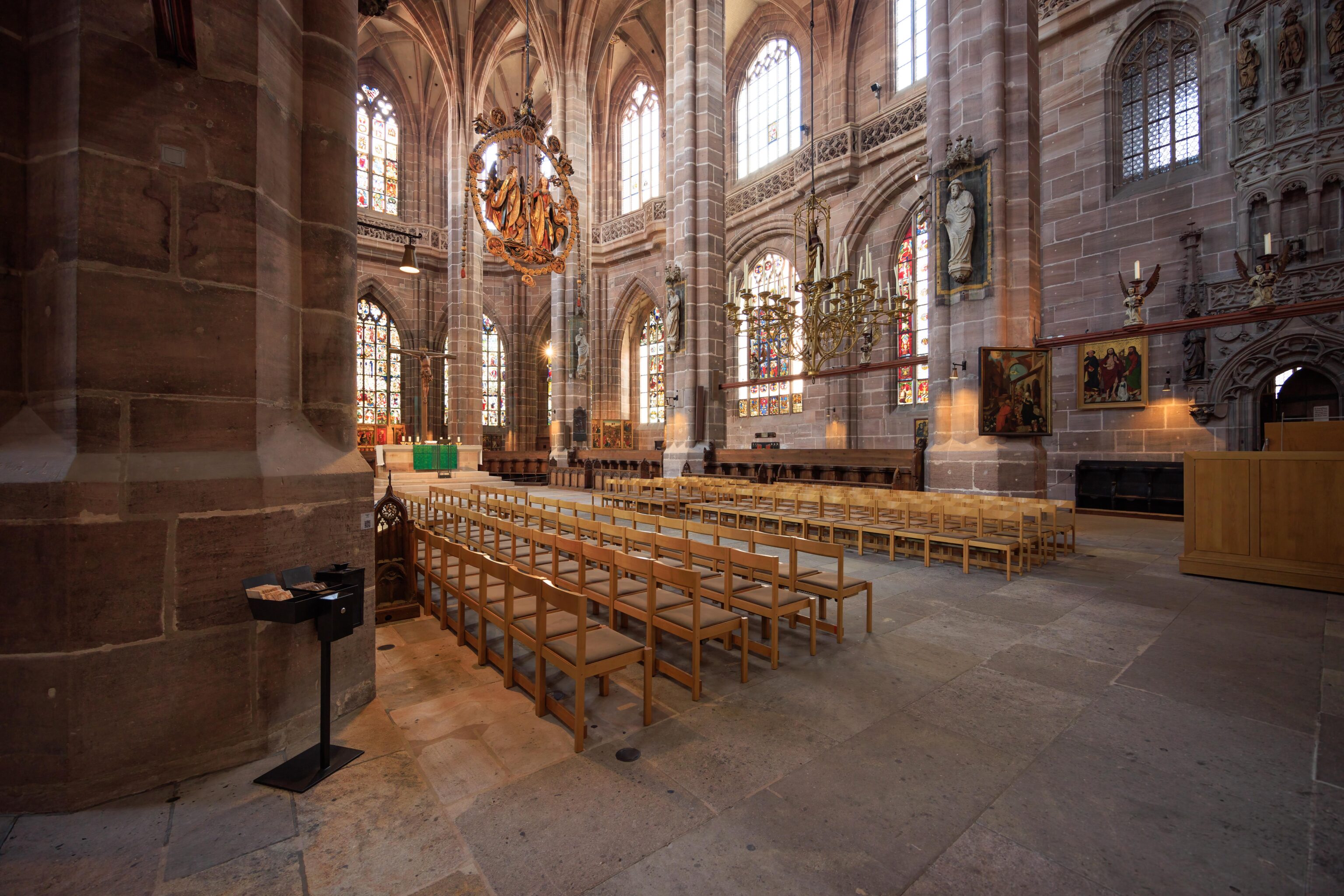


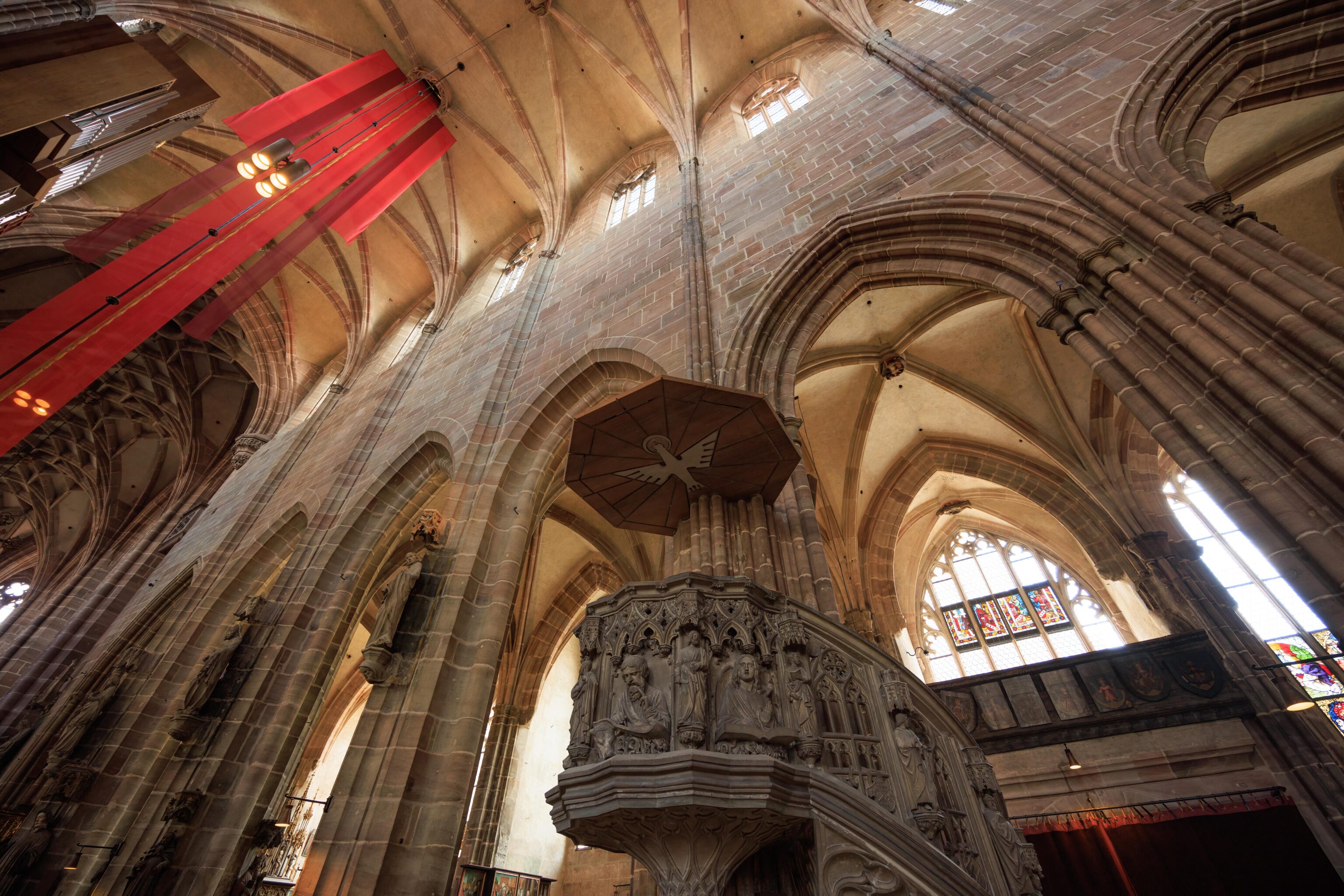
We went through the church in about 10 minutes as they were setting up for a service at 5pm. The actual service was open to visitors but many sections were being cordoned off.

The church from the southwest.
Around the Pegnitz

After leaving the church, we started walking to the west.
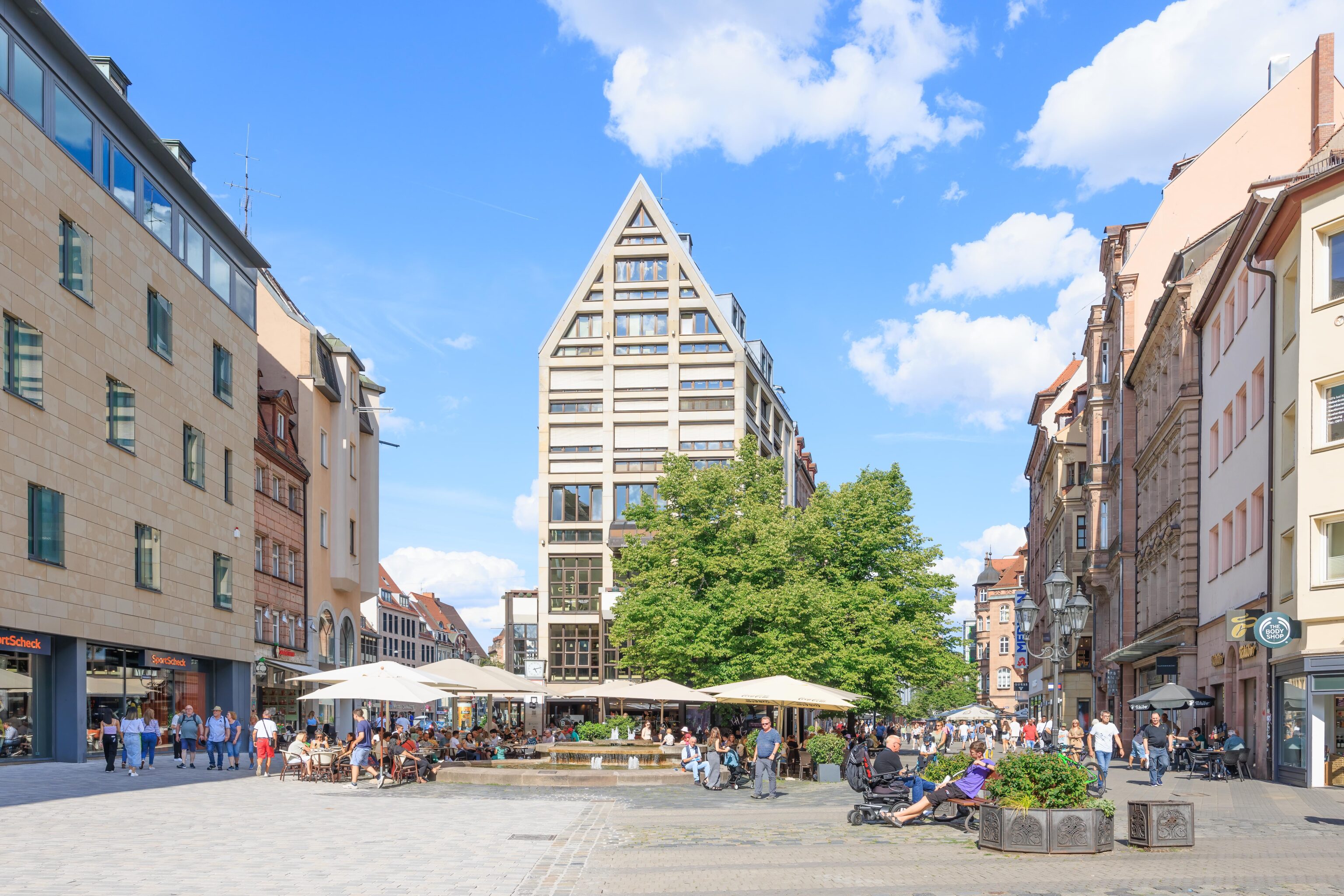
There were definitely a mix of old and new structures! The fountain in front of the building at the far end of the plaza seems to be called the Knöpflesbrunnen.
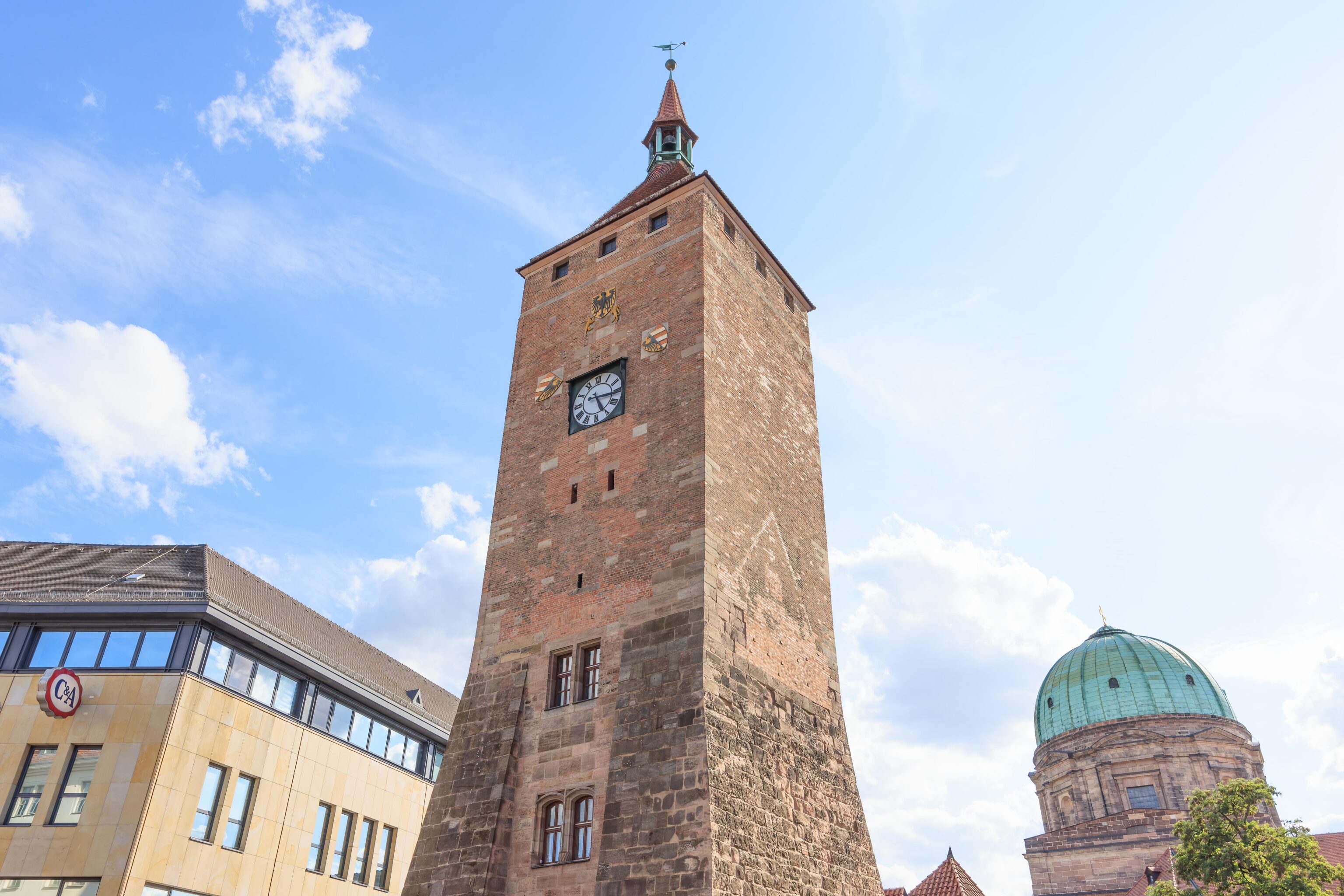
The Weißer Turm (White Tower) U-Bahn station is under this tower just to the west of the Knöpflesbrunnen. We expected the tower to be white, given its name. It clearly is not white. We probably should have looked around to see if there was a sign but we did not. The tower’s German Wikipedia article explains that the tower was originally coated in white plaster but it was removed after World War II and not replaced.
This photo, unfortunately, doesn’t show that it is attached to a gate as well. At some point, there was a city wall that attached to the tower and gate. There is a city wall that remains, with attached towers, around some of the Altstadt. This tower is inside the area enclosed by that wall.

There is a large fountain behind the tower. Presumably, behind would be in this direction as the gate is in the opposite direction. There is quite a bit going on in this fountain with some weird features!

After walking by the White Tower, we headed to the north and reached the Maxbrücke, a bridge that crosses the Pegnitz. The Maxbrücke is the oldest stone bridge in the city. This view is to the west. There is a pedestrian bridge as well as what appears to be a building, or part of the city wall, that spans the river.

Looking to the east, there was a little island in the middle of the river. There is a covered bridge on the south side and a building that goes across the river on the north side.

Rather than cross the river here, we decided to head to the covered bridge. Here, the Maxbrücke is on the left.

The Maxbrücke, to the west, from the covered bridge.

Looking to the east, yet another bridge!
We neglected to take a closer photo of the covered bridge that we were now on. It is the Henkersteg, or Hangman’s Bridge. The Nuremberg Convention and Tourist Office explains:
It was over this wooden bridge that the "Henker" - the Executioner - would walk from his isolated house on the island into the city. In the Middle Ages, the executioner was not allowed to have contact with honorable citizens. The Henkersteg was built after the flood of 1595, which destroyed the previous bridge.
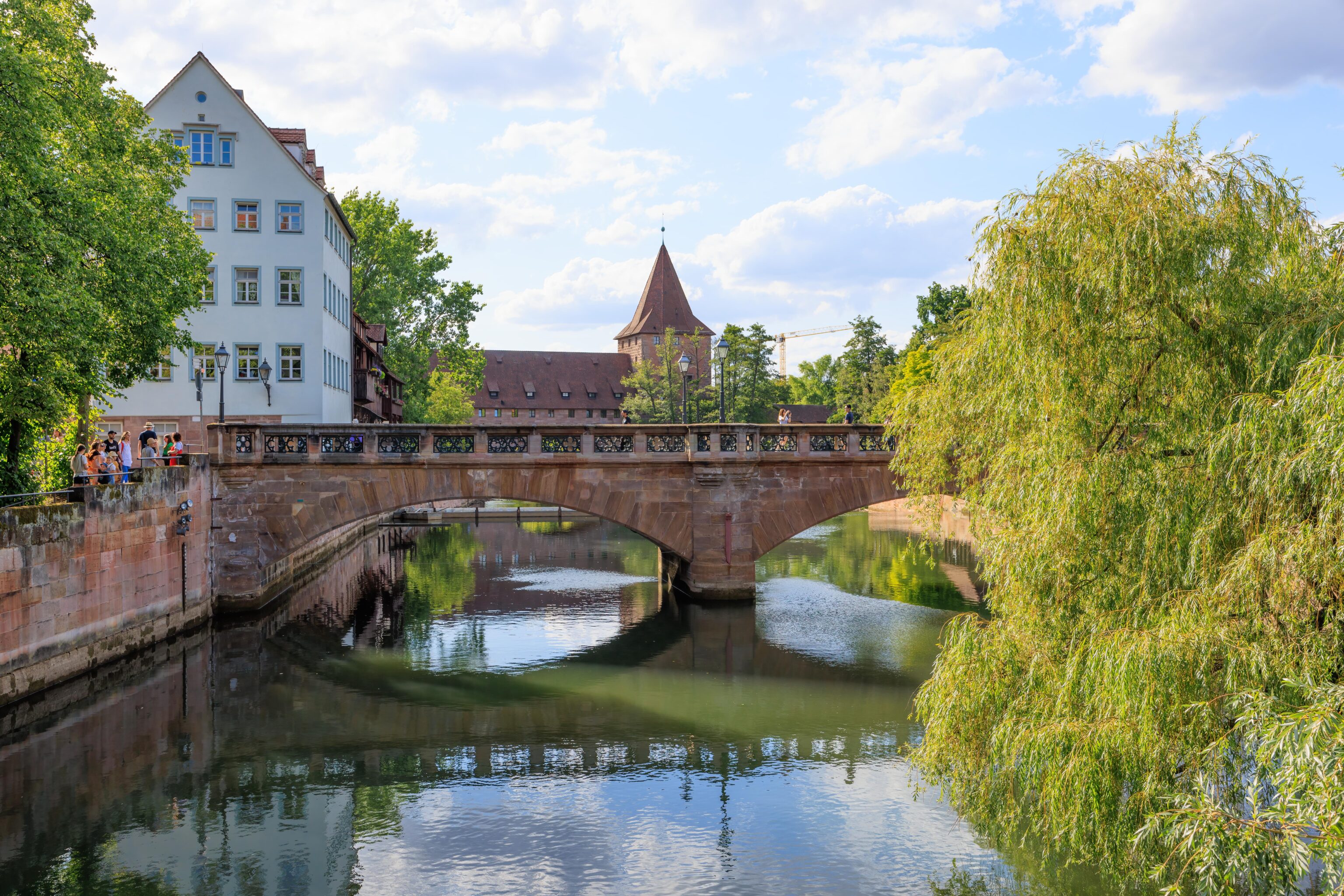
A beautiful view of the Pegnitz and Maxbrücke!

After walking across the Henkersteg, we headed east on the island and crossed the Pegnitz via the Untere Karlsbrücke. From the bridge, we could see the Henkerhaus, translated as Executioner’s House by the museum that is contained within the former residence. The house is built over the Pegnitz.

There is a small bridge that goes to the island’s east end a short distance away.
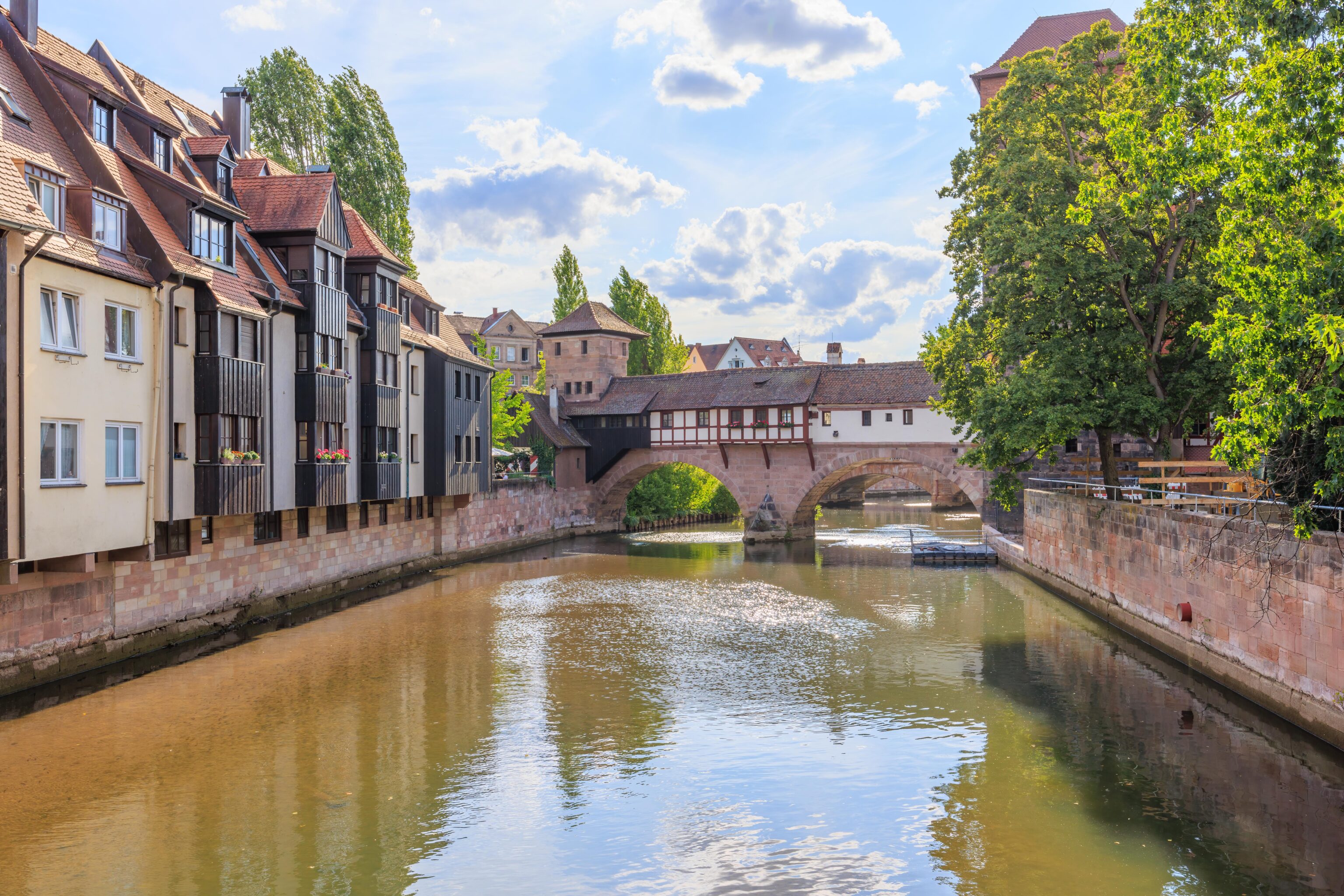
Looking once again to the west towards the Henkerhaus from a bit further north on the bridge.

We ended up back at the Hauptmarkt, just two blocks away from the bridge that we just crossed over. We photographed this building that we had noticed earlier when we were here for lunch. There is a partial clock on the little tower in the corner of the building that works using the shadow cast by the sun!
We decided to visit Buonissimo again for more ice cream!

We once again got two cones but this time with two scoops each! The one on the left was raspberry and strawberry while the one on the right was blueberry and dark chocolate. The blueberry flavor was a bit hard to identify but the other three scoops were all very good and obvious in flavor.
We headed back to the Lorenzkirche U-Bahn station and traveled one stop to the Hauptbahnhof where we ended our day.
The subway cars have displays which show various things, including the news what is effectively PowerPoint form. One of the news stories had a picture of a lion and text that mentioned Berlin and frei (free). Lion and free are often not two words you want to read together. Was there a lion on the loose?
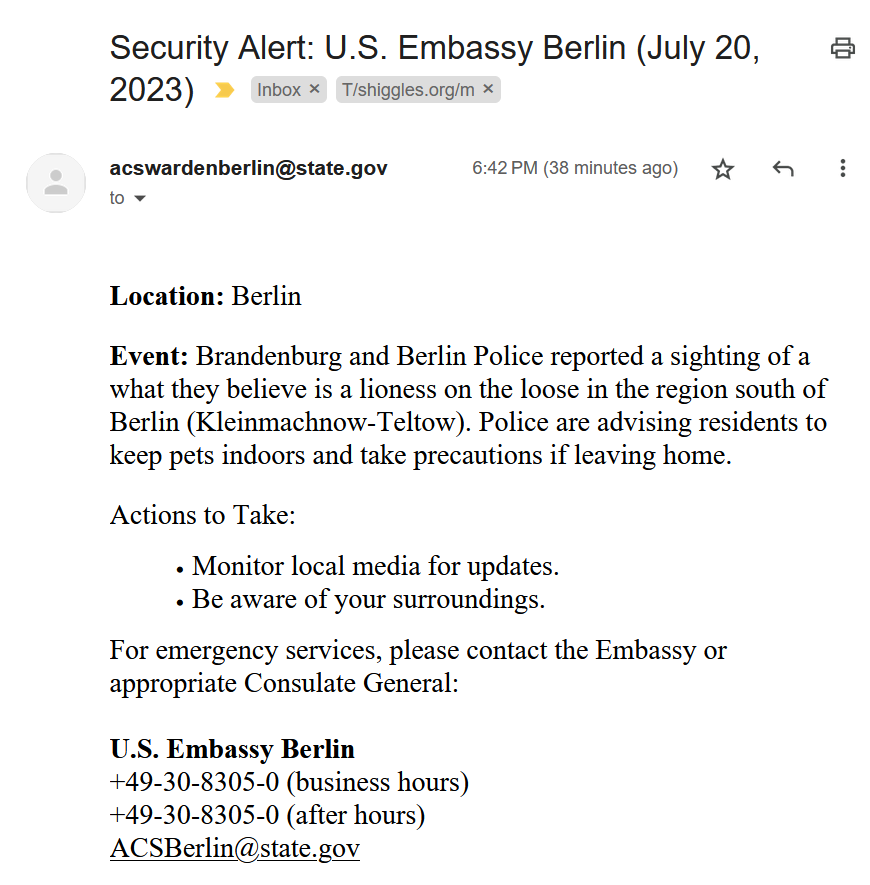
Later on, we got this email from the US Embassy. Indeed, a lion was reported to be on the prowl in Berlin!


